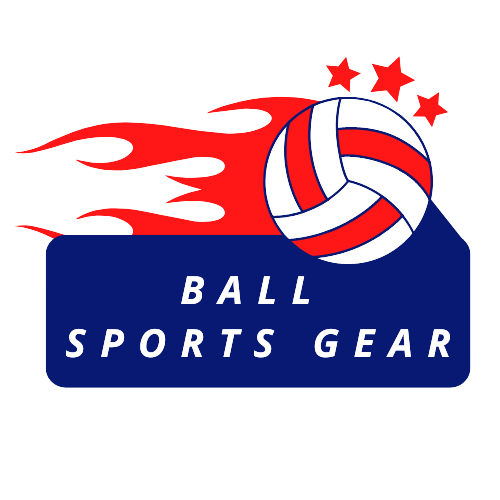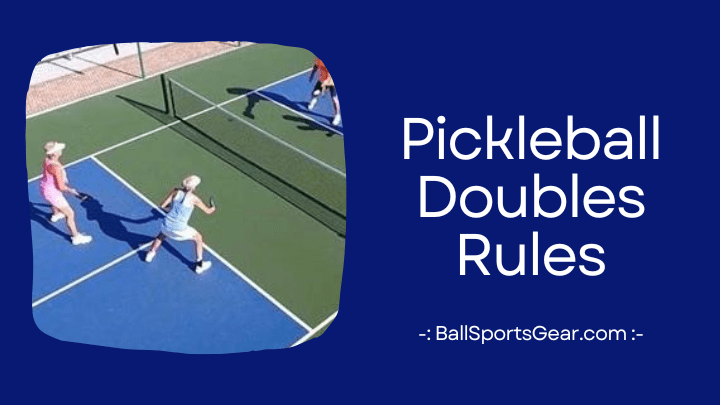Pickleball is a thrilling and entertaining activity that has become quite popular in recent years, particularly among senior citizens. Although it is a simple game to learn, it does have its own set of rules that must be adhered to. In pickleball doubles, players are split into two-person teams and compete against one another. To play pickleball doubles efficiently and without any confusion, it is essential to be aware of the regulations. This manual attempts to give players a thorough explanation of doubles pickleball rules and regulations in order to aid them in learning the sport.
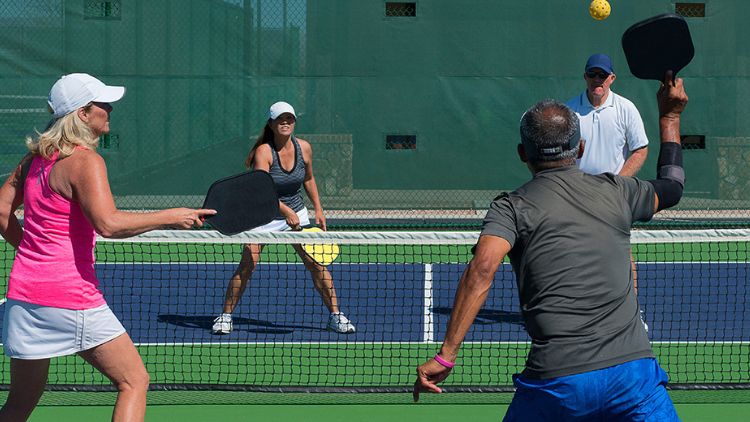
Know Pickleball Doubles Rules
A. Serving
Service order
In pickleball serving rules doubles, the serving team is found by a coin toss or a rally to determine the first server. The team that serves first in the game also serves first in the next game. The first serve of each game is made from the right-hand court.
Faults and double faults
If the server makes a fault, the point is lost. A double fault results in the loss of the serve.
Legal serving techniques
The server must keep both feet behind the baseline while serving, and the paddle head must be below the server’s waist. The serve must be hit underhand and diagonally across the court.
Let Serve
If the ball hits the net on the serve and lands in the proper service court, it is called a let serve, and the server can re-serve without penalty.
B. In-game play
Scoring
The game is played to 11 points, and the winning team must win by two points. A point is scored when the opposing team commits a fault, such as hitting the ball out of bounds, hitting the ball into the net, or violating the non-volley zone rule.
Non-volley zone rule
The kitchen, often referred to as the non-volley zone, is a 7-foot space on either side of the net. Unless the ball has already bounced inside the zone, players are not permitted to strike the ball while standing in the non-volley zone. A fault occurs if a player strikes the ball while positioned in the non-volley zone.
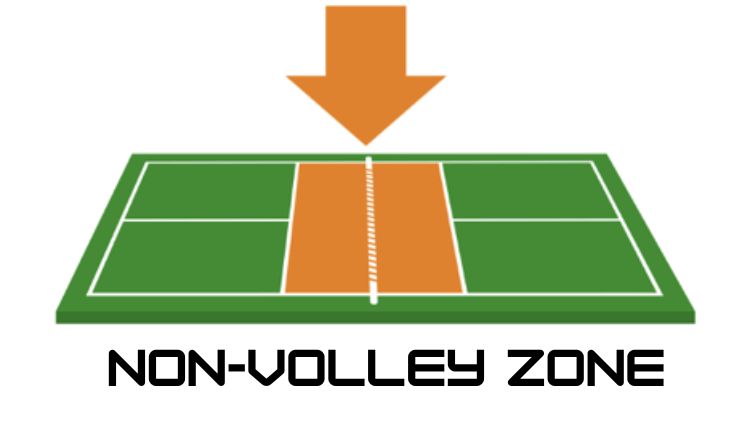
Double bounce rule
After the serve, each team must let the ball bounce once on their side of the court before they can hit it. After the ball has bounced once on each side, either team can hit the ball in the air or let it bounce again.
Faults and violations
Stepping into the non-volley zone before the ball bounces, striking the ball out of bounds, into the net, or hitting the ball more than once are all other faults and violations in addition to the non-volley zone violation.
Foot Fault
A foot fault occurs when the server steps on or over the baseline while serving. If a foot fault occurs, the serve is considered a fault, and the serve is awarded to the other team.
Out of Bounds
A ball is considered out of bounds if it lands outside of the court’s boundaries or touches any part of the court’s boundary lines.
C. Substitutions
Injury substitutions
If a player is injured during the game and unable to continue, the injured player’s team may substitute another player. If the injured player is the server, the substitute player must serve in their place.
Regular substitutions
Teams are allowed to substitute players at any time between points, but only one substitution per team per point is allowed.
1. Positioning
Pickleball rules doubles relies heavily on positioning. Players that use effective placement may cover more of the court, make fewer mistakes, and have a higher chance of winning the point. In pickleball doubles, the two main positioning styles are:
Offensive Positioning
Moving closer to the net when attacking allows you to provide pressure to your opponents. To have them make defensive shots in order to create winning opportunities. Typically, the person at the net makes the first move, while the partner sits back to block any strokes that miss the net player.
Defensive Positioning
Defensive positioning involves moving further back from the net to protect against hard shots and to give players more time to react. The player at the baseline is usually the defender, while the partner moves forward to cover any shots that get past the baseline player.
2. Communication
Effective communication is critical in pickleball doubles. Players need to communicate effectively to avoid confusion and to ensure that they are covering the court efficiently. There are two types of communication in pickleball doubles:
Verbal Communication
Verbal communication involves talking to your partner to convey important information. This may include calling out the type of shot you are hitting, indicating where you are moving on the court, or reminding your partner to cover a particular area.
Non-Verbal Communication
Non-verbal communication involves using signals and body language to communicate with your partner. This may include pointing to a particular area of the court or using hand signals to indicate the type of shot you are hitting.
C. Shot Selection
Another crucial component in pickleball doubles is shot selection. Players must select the appropriate shot for the occasion since different shots may be utilized to accomplish various aims. Three typical shot types utilized in pickleball doubles are listed below:
Dinking
Dinking is a soft shot that is hit over the net and lands in the opponent’s kitchen. Dinking is a great way to slow down the pace of the game and to force opponents to hit defensive shots.
Lobbing
Lobbing is a high-arcing shot that is hit over the opponent’s head and lands deep in their court. Lobbing is an excellent way to put opponents on the defensive and to create opportunities for your team to move forward and take control of the net.
Third Shot Drop
The third shot drop is a gently struck shot that finds its way into the adversary’s kitchen. It is often utilized following a serve and is intended to benefit the serving team by advancing them and allowing them to take control of the net.
How To Win At Pickleball Doubles?
Here are some tips to help you win at pickleball doubles:
Communicate with your partner: Good communication is essential in doubles pickleball. Talk to your partner and make sure you both understand each other’s strengths and weaknesses. You should also discuss the strategy you will use to win the game.
Stay in your assigned court: In pickleball, each player has a designated court to cover. Make sure you stay in your assigned court and don’t try to cover your partner’s area unless necessary. This will help avoid confusion and ensure that both courts are covered at all times.
Play smart: Pickleball is not just about hitting the ball hard; it’s about playing smart. Use your shots wisely and try to place the ball where your opponents are not. Use dinks, drops, and lobs to keep your opponents guessing and to create opportunities for yourself.
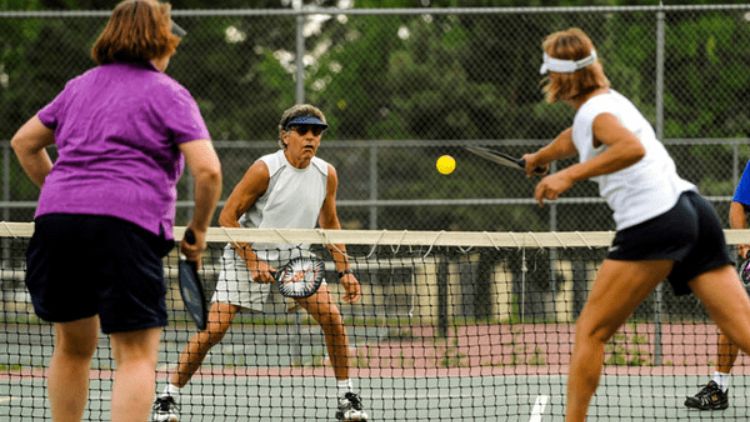
Move as a team: Pickleball doubles requires teams to maneuver together. Be prepared to shift into position to cover your court by anticipating where your partner will hit the ball. Together, cover the court and develop angles that will force your adversaries to defend themselves.
Take advantage of your opponents’ weaknesses: Pay attention to your opponents’ weaknesses and try to exploit them. If they have trouble with high shots, use lobs. If they struggle with low shots, use dinks. If they are slow, hit shots that force them to move quickly.
Keep your cool: Finally, remember to keep your cool. Don’t let mistakes or bad calls get to you. Stay calm and focused, and keep playing your game. Remember, in pickleball, the team that makes the fewest mistakes usually wins.
By following these tips and rules for pickleball doubles, you can improve your chances of winning at pickleball doubles. Remember to practice regularly and to have fun!
Frequently Asked Questions
A: In pickleball doubles, the “two bounce” rule states that following the serve, the receiving team must allow the ball to bounce once before striking it, and then the serving team must allow the ball to bounce once before hitting it.
A: Players win a point in pickleball doubles if the opposing team hits the ball out of bounds or into the net, or if the opposing team fails to hit the ball back over the net.
A: The non-volley zone is a seven-foot area on both sides of the net where players are not allowed to hit the ball before it bounces.
A: The serve order in pickleball doubles starts with the team that won the previous point. The first server on each team starts on the right side of the court.
A: Players get one serve each in pickleball doubles, and the serve must be underhand.
Conclusion
Pickleball doubles is an exciting and pleasant game, but in order to play it well, participants must be aware of the game’s regulations. Although the pickleball doubles rules may initially appear complex, with practise they become second nature. Players may enhance their gaming and stay error-free by adhering to the instructions provided in this detailed guide. Pickleball doubles is a great way to be healthy and have a good time with friends, and knowing the rules is necessary to enjoy yourself to the fullest. Once you are finish learning about doubles you can also read about Pickleball singles rules and kitchen rules in pickleball.
